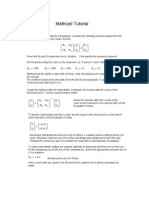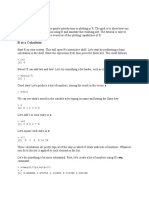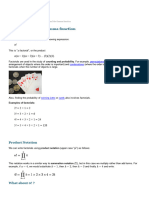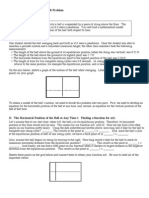Understanding and Using Newton's Method
Uploaded by
Alejandro AguirreUnderstanding and Using Newton's Method
Uploaded by
Alejandro AguirreUnderstanding and Using Newtons Method
Coastal Carolina University
C.C. Edwards
Newtons method is an algorithm that uses the derivative of a function to approximate the zeros of the function. To understand how and why Newtons method works, lets first concentrate on the derivative of a function. One of the first things you learned about the derivative was that it could be used to find the slope, and thus the equation, of the tangent to a curve at a specified point. And one of the really nice things about the tangent to a curve is that it can, under certain circumstances, be used to approximate the curve. To see this, consider Figure 1 which displays a curve and its tangent at the point where x = a. When you zoom in on the point of tangency, as displayed in Figure 2, you see that it becomes difficult to distinguish between the graph of the curve and the graph of the tangent. And if you zoom in again, as in Figure 3, it becomes even more difficult to distinguish between the curve and the tangent. So in the window depicted in Figure 3, the points on the tangent can be used to approximate the points on the curve.
Figure 1
Figure 2
Figure 3
Can you use the points on the tangent to approximate the points on the curve which are not close to the point of tangency? In particular, can you use the zero of the tangent to approximate the zero of a function? In Figure 1, the zero z of the function and the zero b of the tangent look kind of close, but when you zoom in on the zero of the function they will no longer look very close. This is pictured at the right where a is the x-coordinate of the point of tangency, z is the zero of the function, and b is the zero of the tangent. In this situation, the zero of
the tangent, b, doesnt give a very good approximation of the zero, z, of the function. But what if you move the point of tangency closer to the zero of the function? Since b is closer to z than a, lets create a tangent to the function at the point where x = b. The result is pictured at the right where c is the zero of the new tangent. As you can see, c is a much better approximation of z than b. And you could probably get an ever better approximation if you continued this process by looking at the zero of the tangent at the point where x = c. This is the basis of Newtons method. That is, to approximate a zero of a function f ( x) : 1. Pick a value a0 that is close to the zero of the function. 2. Find the zero a1 of the tangent to f ( x) at the point (a0 , f (a0 )) . 3. Find the zero a2 of the tangent to f ( x) at the point (a1 , f (a1 )) . 4. Continue this iterative process. Each new an +1 should be a better approximation of the zero of the function than the previous approximation an .
EXERCISES:
1. Find a formula for an +1 . 2. Use Newtons method and the Sequence application on your calculator to approximate, accurate to two decimal places, the zeros of f ( x) = 2 x 3 + x 2 x + 1 . 3. Use Newtons method to approximate places. 3 , accurate to three decimal
Answers and Explanations
Using the ClassPad 300
1. Since f (an ) is the slope of the tangent to the graph of f ( x) at the point (an , f (an )) , the equation of this tangent is y f (an ) = f (an ) ( x an ) . This tangent crosses the x-axis when y = 0. Setting y = 0 in the equation f (an ) . In Newtons of the tangent and solving for x gives x = an f (an ) method, this zero is denoted by an +1 . So Newtons method consists of the iterative function
an +1 = an
f (an ) . f (an )
2. The following steps show how to solve this problem using a ClassPad 300. Tap m on the Icon panel at the bottom of the screen and then tap the eActivity application A, as illustrated in the first picture in Figure 1. If the screen is not blank, as in the second picture in Figure 1, tap File on the Menu bar and then tap New in the drop-down menu. When requested to do so, tap OK to clear the screen, as illustrated in the third picture in Figure 1.
Figure 1
Use the define command to define the function f ( x) = 2 x 3 + x 2 x + 1 :
To do this, first tap in the first drop down menu on the Toolbar to change from text entries to calculation entries. Next press k on the Keypad then tap the 0 tab in the top row of the keyboard. Use the stylus and the keyboard to enter the command define and then tap the space bar at the bottom of the Keyboard. Then use the Keyboard to enter the letter f and then use the Keypad to enter the rest of the formula, as displayed at the right. When you are finished entering the formula, press E to store the definition of the function in the calculator.
Store the derivative of f(x) in d(x):
To do this first enter the define command, followed by a space. (Note: You can copy this command from the definition of f(x) and then paste it on the screen, or you can enter it from the Keyboard.) Then enter the letter d and use the Keypad to enter (x) =. Next tap the ) tab in the top row of the Keyboard and in then tap K at the bottom of the Keyboard. Tap the last row of the 2D menu and use the Keypad to enter x. Then tap to the left of the box where you enter the function and enter f(x). When you are finished, press E to store the definition of the function in the calculator. (Note: Tap 0 to enter f from the Keyboard and use the Keypad to enter (x) =.)
Graph f(x) and estimate where the graph crosses the x-axis:
To do this, tap Insert on the Menu bar and then tap Graph in the drop down menu. A graph window is displayed at the bottom of the screen.
Then highlight and drag the definition of f(x) to the graph window to display its graph. From the graph you see that a reasonable approximation of the zero of the function is 1. This value will be used as your first entry, a0, in the sequence for Newtons method.
Define the sequence used in Newtons method:
To do this, tap Insert on the Menu bar and then tap Sequence Editor in the drop down menu. Tap to the left of the box provided for the definition of an+1 and then tap n,an on the Menu bar. Tap an in the drop down menu to start the definition of Newtons method and then press on the Keypad. Press k and use the Keyboard and Keypad to enter (f(x)/d(x)). (Note: only the letters need to be entered using the Keyboard, all other symbols can be enterer from the Keypad.) To change x to an, as required by Newtons method, press 9 on the top line of the Keyboard and then press on the last line of the Keyboard. Then press U to insert the with command. Then enter x =, and then use the menu at the bottom of the screen to enter the symbol an. When finished, press E. Use the Keypad to enter 1 as the initial value of the sequence, and then press E.
Display the results of using Newtons method:
To do this, tap 2 on the Toolbar to display the results of using Newtons method to find the zero of the function.
Conclusion: From the table it is apparent that the zero, accurate to two decimal places, is 1.23 . 3. Since 3 is the root of the function f(x) = x2 3, you can simply edit the definitions of f(x) and d(x) stored in your calculator and use the formula for Newtons method that is already stored in sequence an+1. Heres how you do this.
Close the display in to top window by pressing Oon the Menu bar and then pressing Close in the drop down menu. Highlight the definition of f(x) and use the Keypad to enter the new definition x2 3. When finished, press E. Highlight the definition of the derivative and then press E to calculate the derivative of the newly entered function. Look at the graph of the redefined function to determine where it crosses the x-axis by repeating the following steps you used with the original function: Then highlight and drag the definition of f(x) to the graph window to display its graph. From the graph you see that a reasonable approximation of the zero of the function is 1. This value will be used as your first entry, a0, in the sequence for Newtons method.
To view the graph of the redefined f(x), return the calculator to Function mode by pressing 3 and then press to display the graph. From the graph you see that a possible value for x1 in Newtons method is 2. A better guess may be 1.9. To enter this guess in the definition of Newtons method you must change the value of ui1 in the Sequence editor. To do this, press 3 to put the calculator back in Sequence mode and then press to enter the Sequence editor. Then press to place the previous value of ui1 on the command line, enter the new value, and then press . To view the values of the sequence, starting with the 100th term, press . It will take awhile for the table to display. From the table you see that the square root of 3 is, accurate to three decimal places, 1.732.
You might also like
- Ebooks File Cambridge Essential English Dictionary 2nd Edition Cambridge University Press All Chapters100% (3)Ebooks File Cambridge Essential English Dictionary 2nd Edition Cambridge University Press All Chapters78 pages
- Vertical Vapor Liquid Separator Sizing: Chemical Engineering CalculationsNo ratings yetVertical Vapor Liquid Separator Sizing: Chemical Engineering Calculations8 pages
- 3764guide To Using The Ti-Nspire Specialist V2.00No ratings yet3764guide To Using The Ti-Nspire Specialist V2.0011 pages
- 1.3 Support 1 - Absolute Value Functions: High School Differential Calculus CourseNo ratings yet1.3 Support 1 - Absolute Value Functions: High School Differential Calculus Course3 pages
- Return To List of Lessons: Calculator Lesson 4 More Graphing: Choosing The Graph WindowNo ratings yetReturn To List of Lessons: Calculator Lesson 4 More Graphing: Choosing The Graph Window2 pages
- Homework Assignment # 10: MATH 235 - Mathematical Models in Science and EngineeringNo ratings yetHomework Assignment # 10: MATH 235 - Mathematical Models in Science and Engineering4 pages
- L004 More Graphing Choosing A Graph WindowNo ratings yetL004 More Graphing Choosing A Graph Window2 pages
- Maple Tutorial For Math 243: Please Send Suggestions and Corrections To Rakesh@math - Udel.eduNo ratings yetMaple Tutorial For Math 243: Please Send Suggestions and Corrections To Rakesh@math - Udel.edu32 pages
- Lecture & Note-Taking Guide: To Accompany Calculus Concepts, 13th Edition Sherry Biggers - eBook PDF download100% (7)Lecture & Note-Taking Guide: To Accompany Calculus Concepts, 13th Edition Sherry Biggers - eBook PDF download60 pages
- Area Approximation Using Trapezium Rule - CASIO fx-82EXNo ratings yetArea Approximation Using Trapezium Rule - CASIO fx-82EX4 pages
- Get Lecture & Note-Taking Guide: To Accompany Calculus Concepts, 13th Edition Sherry Biggers - Ebook PDF Free All Chapters100% (4)Get Lecture & Note-Taking Guide: To Accompany Calculus Concepts, 13th Edition Sherry Biggers - Ebook PDF Free All Chapters19 pages
- Lecture & Note-Taking Guide: To Accompany Calculus Concepts, 13th Edition Sherry Biggers - eBook PDFinstant download100% (2)Lecture & Note-Taking Guide: To Accompany Calculus Concepts, 13th Edition Sherry Biggers - eBook PDFinstant download50 pages
- ME 17 - Homework #5 Solving Partial Differential Equations Poisson's EquationNo ratings yetME 17 - Homework #5 Solving Partial Differential Equations Poisson's Equation10 pages
- National Institute of Technology Karnataka, Surathkal Department of Physics PH755: Assignment 2No ratings yetNational Institute of Technology Karnataka, Surathkal Department of Physics PH755: Assignment 23 pages
- Complete Download Lecture & Note-Taking Guide: To Accompany Calculus Concepts, 13th Edition Sherry Biggers - eBook PDF PDF All Chapters100% (8)Complete Download Lecture & Note-Taking Guide: To Accompany Calculus Concepts, 13th Edition Sherry Biggers - eBook PDF PDF All Chapters69 pages
- Instant Download Lecture & Note-Taking Guide: To Accompany Calculus Concepts, 13th Edition Sherry Biggers - Ebook PDF PDF All Chapters100% (8)Instant Download Lecture & Note-Taking Guide: To Accompany Calculus Concepts, 13th Edition Sherry Biggers - Ebook PDF PDF All Chapters41 pages
- Exponential Functions: General Mathematics O. OronceNo ratings yetExponential Functions: General Mathematics O. Oronce55 pages
- Parametric Equations of Conic Sections: Mun Chou, FongNo ratings yetParametric Equations of Conic Sections: Mun Chou, Fong8 pages
- Lecture & Note-Taking Guide: To Accompany Calculus Concepts, 13th Edition Sherry Biggers - eBook PDF all chapter instant download100% (6)Lecture & Note-Taking Guide: To Accompany Calculus Concepts, 13th Edition Sherry Biggers - eBook PDF all chapter instant download56 pages
- ECE 410 Digital Signal Processing D. Munson University of Illinois A. SingerNo ratings yetECE 410 Digital Signal Processing D. Munson University of Illinois A. Singer14 pages
- Chapter 2 - Intercepts, Zeros, And SolutionsNo ratings yetChapter 2 - Intercepts, Zeros, And Solutions22 pages
- FUNCTIONS_6bf5bb85-965f-440e-a69d-f2d2869ed80eNo ratings yetFUNCTIONS_6bf5bb85-965f-440e-a69d-f2d2869ed80e40 pages
- Bagasse Compaction - Interim Report Research Report No 5 81 PDFNo ratings yetBagasse Compaction - Interim Report Research Report No 5 81 PDF51 pages
- 2000 - Moor - Belt Vs Chain-Slat BagasseNo ratings yet2000 - Moor - Belt Vs Chain-Slat Bagasse5 pages
- 1994 - Bernhardt - Dry Cleaning of SugarcaneNo ratings yet1994 - Bernhardt - Dry Cleaning of Sugarcane6 pages
- Startup Fluid Analysis: Department Editor: Rebekkah MarshallNo ratings yetStartup Fluid Analysis: Department Editor: Rebekkah Marshall1 page
- ES 230 Graphical Syllabus Spring 2010: Stress Material Properties StrainNo ratings yetES 230 Graphical Syllabus Spring 2010: Stress Material Properties Strain1 page
- TCP Training April - May 2006 CFB Boiler Components: Foster Wheeler Energia Oy Jyrki Appelgren100% (4)TCP Training April - May 2006 CFB Boiler Components: Foster Wheeler Energia Oy Jyrki Appelgren43 pages
- BS 476-3-1975 - Fire Test On Building Materials & Structures - Part 3 - External Fire Exposure Roof TestsNo ratings yetBS 476-3-1975 - Fire Test On Building Materials & Structures - Part 3 - External Fire Exposure Roof Tests14 pages
- Peace Corps OST Focus In/Train Up (FITU) Focus in - Train Up Action PlanNo ratings yetPeace Corps OST Focus In/Train Up (FITU) Focus in - Train Up Action Plan2 pages
- An Explicit Equation For Friction Factor in PipeNo ratings yetAn Explicit Equation For Friction Factor in Pipe2 pages
- TFN Transes - HX of NRG To NRG TheoristNo ratings yetTFN Transes - HX of NRG To NRG Theorist14 pages
- Theology and The Curriculum: Univer1Jit11, Is Still Seen As A Major Philosophical Statement On The NaNo ratings yetTheology and The Curriculum: Univer1Jit11, Is Still Seen As A Major Philosophical Statement On The Na11 pages
- Class 10 Chemistry Chapter 4 Revision Notes100% (1)Class 10 Chemistry Chapter 4 Revision Notes2 pages
- Ebooks File Cambridge Essential English Dictionary 2nd Edition Cambridge University Press All ChaptersEbooks File Cambridge Essential English Dictionary 2nd Edition Cambridge University Press All Chapters
- Vertical Vapor Liquid Separator Sizing: Chemical Engineering CalculationsVertical Vapor Liquid Separator Sizing: Chemical Engineering Calculations
- 1.3 Support 1 - Absolute Value Functions: High School Differential Calculus Course1.3 Support 1 - Absolute Value Functions: High School Differential Calculus Course
- Return To List of Lessons: Calculator Lesson 4 More Graphing: Choosing The Graph WindowReturn To List of Lessons: Calculator Lesson 4 More Graphing: Choosing The Graph Window
- Homework Assignment # 10: MATH 235 - Mathematical Models in Science and EngineeringHomework Assignment # 10: MATH 235 - Mathematical Models in Science and Engineering
- Maple Tutorial For Math 243: Please Send Suggestions and Corrections To Rakesh@math - Udel.eduMaple Tutorial For Math 243: Please Send Suggestions and Corrections To Rakesh@math - Udel.edu
- Lecture & Note-Taking Guide: To Accompany Calculus Concepts, 13th Edition Sherry Biggers - eBook PDF downloadLecture & Note-Taking Guide: To Accompany Calculus Concepts, 13th Edition Sherry Biggers - eBook PDF download
- Area Approximation Using Trapezium Rule - CASIO fx-82EXArea Approximation Using Trapezium Rule - CASIO fx-82EX
- Get Lecture & Note-Taking Guide: To Accompany Calculus Concepts, 13th Edition Sherry Biggers - Ebook PDF Free All ChaptersGet Lecture & Note-Taking Guide: To Accompany Calculus Concepts, 13th Edition Sherry Biggers - Ebook PDF Free All Chapters
- Lecture & Note-Taking Guide: To Accompany Calculus Concepts, 13th Edition Sherry Biggers - eBook PDFinstant downloadLecture & Note-Taking Guide: To Accompany Calculus Concepts, 13th Edition Sherry Biggers - eBook PDFinstant download
- ME 17 - Homework #5 Solving Partial Differential Equations Poisson's EquationME 17 - Homework #5 Solving Partial Differential Equations Poisson's Equation
- National Institute of Technology Karnataka, Surathkal Department of Physics PH755: Assignment 2National Institute of Technology Karnataka, Surathkal Department of Physics PH755: Assignment 2
- Complete Download Lecture & Note-Taking Guide: To Accompany Calculus Concepts, 13th Edition Sherry Biggers - eBook PDF PDF All ChaptersComplete Download Lecture & Note-Taking Guide: To Accompany Calculus Concepts, 13th Edition Sherry Biggers - eBook PDF PDF All Chapters
- Instant Download Lecture & Note-Taking Guide: To Accompany Calculus Concepts, 13th Edition Sherry Biggers - Ebook PDF PDF All ChaptersInstant Download Lecture & Note-Taking Guide: To Accompany Calculus Concepts, 13th Edition Sherry Biggers - Ebook PDF PDF All Chapters
- Exponential Functions: General Mathematics O. OronceExponential Functions: General Mathematics O. Oronce
- Parametric Equations of Conic Sections: Mun Chou, FongParametric Equations of Conic Sections: Mun Chou, Fong
- Lecture & Note-Taking Guide: To Accompany Calculus Concepts, 13th Edition Sherry Biggers - eBook PDF all chapter instant downloadLecture & Note-Taking Guide: To Accompany Calculus Concepts, 13th Edition Sherry Biggers - eBook PDF all chapter instant download
- ECE 410 Digital Signal Processing D. Munson University of Illinois A. SingerECE 410 Digital Signal Processing D. Munson University of Illinois A. Singer
- A-level Maths Revision: Cheeky Revision ShortcutsFrom EverandA-level Maths Revision: Cheeky Revision Shortcuts
- Ti 84 Plus Calculator: QuickStudy Laminated Reference GuideFrom EverandTi 84 Plus Calculator: QuickStudy Laminated Reference Guide
- Basic Exercises for Competitive Programming: PythonFrom EverandBasic Exercises for Competitive Programming: Python
- Bagasse Compaction - Interim Report Research Report No 5 81 PDFBagasse Compaction - Interim Report Research Report No 5 81 PDF
- Startup Fluid Analysis: Department Editor: Rebekkah MarshallStartup Fluid Analysis: Department Editor: Rebekkah Marshall
- ES 230 Graphical Syllabus Spring 2010: Stress Material Properties StrainES 230 Graphical Syllabus Spring 2010: Stress Material Properties Strain
- TCP Training April - May 2006 CFB Boiler Components: Foster Wheeler Energia Oy Jyrki AppelgrenTCP Training April - May 2006 CFB Boiler Components: Foster Wheeler Energia Oy Jyrki Appelgren
- BS 476-3-1975 - Fire Test On Building Materials & Structures - Part 3 - External Fire Exposure Roof TestsBS 476-3-1975 - Fire Test On Building Materials & Structures - Part 3 - External Fire Exposure Roof Tests
- Peace Corps OST Focus In/Train Up (FITU) Focus in - Train Up Action PlanPeace Corps OST Focus In/Train Up (FITU) Focus in - Train Up Action Plan
- Theology and The Curriculum: Univer1Jit11, Is Still Seen As A Major Philosophical Statement On The NaTheology and The Curriculum: Univer1Jit11, Is Still Seen As A Major Philosophical Statement On The Na




































































































